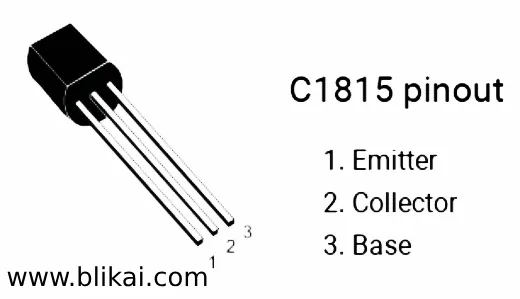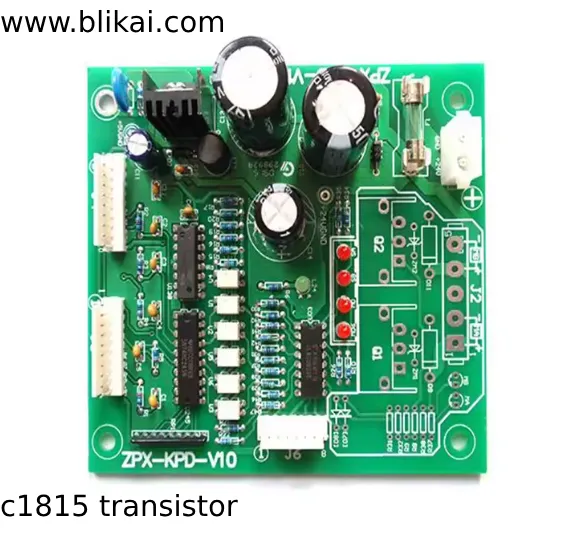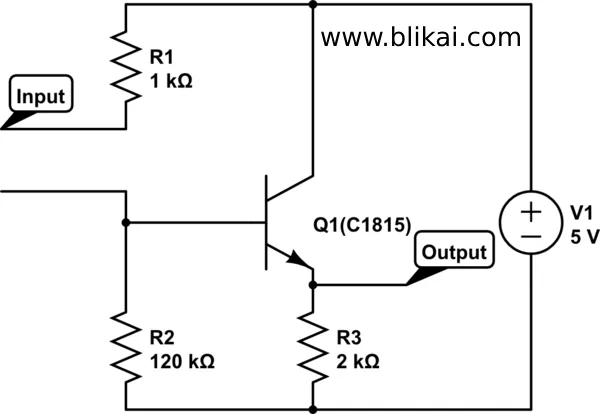C1815 Transistor: What You Need to Know?
I. Introduction
A common bipolar junction transistor (BJT) utilized in switching and amplification applications, the C1815 transistor is a crucial part of electronic circuits. Its adaptability and dependability in a range of electrical circuits account for its significance. The C1815 transistor is widely used in devices such as audio amplifiers and sensor signal amplification because of its capacity to drive higher currents at comparatively low power consumption and magnify tiny signals. Due to its ubiquitous availability and affordability, it is necessary for a lot of electronic designs.
II. Basics of C1815 Transistor
A. Features
Audio Frequency Amplifier and High−Frequency OSC
Complement to KSA1015
Collector−Base Voltage: VCBO = 50 V
A Pb−Free Device
B. Parameter
Collector−Base Voltage:60V
Collector−Base Voltage:50V
Emitter−Base Voltage:5V
Collector Current:150mA
Base Current:50mA
Junction Temperature:°C
Storage Temperature Range:−55 to 150°C
C. Operating principles
The C1815 functions as an NPN transistor and is grounded on the movement of charge carriers, or electrons, from the emitter to the collector region. A bigger current overflows between the emitter and collector outstations when a lower current is delivered to the base outstation. Its function as a signal amplifier or switch in electrical circuits depends on this amplifying exertion.
D. Pinout configuration
Three terminals are usually present on a C1815 transistor:
Emitter (E)
Base (B)
Collector (C)

The emitter in a TO-92 package is often attached to a metal fuse, which facilitates easy heat dissipation. To correctly integrate the transistor into the circuit and ensure appropriate bias voltage and operation, it is essential to understand the pinout arrangement. Referencing the datasheet or package marking is essential to identify the pinout accurately.
III. Applications of C1815 Transistor
A. Amplification circuits
The C1815 transistor is mostly used in amplifier circuits, where it boosts the intensity of electrical impulses. It is frequently utilized in microphone preamplifiers, audio amplifiers, and other low power signal amplification circuits because of its low signal amplification power. The C1815 accurately reproduces signals with increased amplitude by adjusting the current flow between its emitter and collector terminals in response to the input signal to the main terminal.
B. Switching circuits
In switching circuits, the C1815 transistor is also frequently utilized as a control element to manage the current flowing through the load. Depending on the voltage provided to the base terminal, it functions in either the off or saturate zones in switching applications. This feature makes it possible to swiftly turn on and off circuits or devices, which makes it appropriate for uses like motor control circuits, LED drivers, and relay drivers.
C. Oscillator circuits
The C1815 transistor is essential for producing periodic waveforms like sine, square, and triangle waves in oscillator circuits. The transistor oscillates at a defined frequency that is set by the circuit parameters when it is designed with passive components like resistors, capacitors, and inductors. This makes it helpful in applications where exact time and waveform production are crucial, like clock circuits, frequency modulation (FM) transmitters, and signal generators.
IV. C1815 Transistor in Practical Circuits
A. Audio amplifiers
The C1815 transistor is frequently used in sound amplifiers to amplify weak sound signals coming from musical instruments or microphones. Transistors efficiently boost signal intensity without sacrificing signal quality by adjusting collector-emitter current based on the input signal applied to the base terminal. Because of this, the C1815 transistor can be used in consumer audio equipment such as headphone amplifiers, portable speakers, and other modest volume audio amplifier circuits.

B. LED drivers
LED( light emitting diode) motorists regulate the current passing through the diodes to guarantee life and indeed brilliance. generally, LED motorist circuits use the C1815 transistor to switch LEDs on and off in response to control signals. The transistor ensures accurate control of LED brilliance situations by applying palpitation range modulation( PWM) ways to modulate the current through the LEDs. Because of this, it's a pivotal part of numerous LED lighting operations, similar as ornamental, automotive, and signs lighting.
C. Signal generators
Signal creators produce electrical waveforms of colorful types and frequentness for testing, estimation, and dimension purposes. The C1815 transistor plays a vital part in signal creator circuits, particularly in low- frequence oscillator configurations. By performing as a switch or amplifier within the oscillator circuit, the transistor helps induce stable and accurate periodic waveforms needed for testing electronic outfit, analyzing circuits, and simulating real- world signals. This makes it necessary in laboratories, exploration installations, and electronic testing surroundings.
V. Considerations and Tips for Using C1815
A. Voltage and current ratings
To ensure dependability and prevent harm, it is crucial to take into account the voltage and current specifications of the C1815 transistor when utilizing it in electronic circuits. The highest voltage that can be given to these terminals without resulting in faults or failures is determined by the maximum collector base voltage (VCBO) and the maximum collector-to-emitter voltage (VCEO). Comparably, a transistor's maximum current that it can safely accept without overheating or going beyond its current carrying capacity is determined by its maximum collector current (IC). Following these ratings will guarantee the C1815 transistor operates well and lasts a long time in a range of applications.
B. Thermal management
When incorporating the C1815 transistor into electrical circuits, proper thermal operation is essential, particularly in situations where it'll run at high current or power. It's important to keep an eye on the transistor's junction temperature( TJ) to help overheating, which over time can reduce trustability and performance. To maintain the transistor temperature within respectable bounds, sufficient heat immersion or heat dispersion ways must be employed. likewise, maintaining sufficient ventilation and preventing PCB element traffic can aid in efficiently dissipating heat and extending the lifetime of the C1815 transistor.
C. Component selection guidelines
The choice of extra parts, such as resistors, capacitors, and other semiconductor devices, should be carefully considered when creating circuits for the C1815 transistor. To get the best possible circuit performance and stability, match the properties of the transistor with appropriate external components. The particular needs of the application and the C1815 transistor's working circumstances should be taken into consideration while choosing parameters such bias resistors, coupling capacitors, and load resistance. Achieving the intended circuit performance and reliability can be facilitated by following the design guidelines provided by component manufacturers and the suggestions found in data sheets.

VI. Conclusion
To sum up, the C1815 transistor has several benefits, such as its affordability, adaptability, and compact size. It is essential in a variety of circuit applications, such as LED drivers and audio amplifiers, due to its capacity to switch and amplify electronic signals. Its durability and dependability in harsh settings also guarantee consistent performance, which makes it the top option for both electronics enthusiasts and designers.
Final Thoughts
The C1815 transistor will continue to be the dependence of electronic design as technology advances because it provides reliable performance and rigidity in a wide range of operations. When designing circuits that use the C1815 transistor, contrivers and masterminds must take into account variables including voltage and current, thermal control, and element selection guidelines in order to maximize circuit performance and continuance. unborn electronics will continue to be greatly told by the C1815 transistor if it's well allowed out and used.
FAQ
1. What is the C1815 transistor?
A popular NPN bipolar junction transistor( BJT) for general- purpose operation in electrical circuit switching and modification is the C1815.
2. What are the main characteristics of the C1815 transistor?
Maximum collector current( IC) of 150 mA, maximum collector- to- emitter voltage( VCEO) of 50 V, and maximum power dispersion( PD) of 400 mW are typical values for the C1815 transistor.
3. What are the pin configurations of the C1815 transistor?
The emitter, base, and collector operators are the three common operators of a C1815 transistor. It adheres to the typical NPN transistor's EBC pinout layout.
4. What are the common applications of the C1815 transistor?
Because of its low noise and high current capabilities, the C1815 transistor is constantly employed in a wide range of electronic circuits, including switching operations, LED motorists, audio amplifiers, and signal creators.
5. What are the operating conditions for the C1815 transistor?
Within a predetermined range of voltage, current, and temperature, the C1815 transistor functions. It's critical to cleave to the manufacturer's data distance for the proper operating parameters in order to guarantee reliable functioning.
6. How do I identify the C1815 transistor in a circuit?
Transistor C1815 is frequently linked on the packaging as" C1815" or a analogous alphanumeric identifier. It can be honored by its distinct electrical parcels and pin arrangement.
7. Where can I purchase C1815 transistors?
C1815 transistors are fluently attained from original electronics stores, internet merchandisers, and wholesalers of electrical factors. They're constantly offered for sale independently or in volume, depending on the provider.
8. Are there any common issues or considerations when using C1815 transistors?
To guarantee the stylish possible performance and responsibility of circuit designs, some frequent factors to take into account are voltage and current conditions, thermal operation, and applicable biasing.
Junction Field-Effect Transistors: Principles, Applications, and Advantages
Insulated Gate Bipolar Transistor:Features and Pinout
PNP Transistor? Construction, Working & Applications
BSN254A Transistor: Applications, Datasheet, and Equivalent
2N3904S Transistor: Features, Applications, and Datasheet
13009D Transistor: Applications, Equivalent and Specifications
2SA733 Transistor: Applications, Features, and Specifications
2N4401 NPN Transistor: Datasheet, Applications, and Features
What is the BC547 Transistor? Its Features & Applications
BC338 NPN Transistor: Features, Applications, and FAQ











